The Titan Legions first appeared in the 1988 game, Adeptus Titanicus, and I'm sure you all know by now the old story. How, you know, to justify two identical armies fighting against each other, Games Workshop had to come up with an in-universe reason. Thus the Horus Heresy was born, a civil war that tore the Imperium into two, and explained why you basically had two identical forces fighting against each other. It helped to keep costs down so that you could just sell the same sprue twice or something. As you will see below, the sprues were divided into red and blue, so that two players can use them.
Each box had 12 Warlord Titans and 8 styrofoam (?) buildings and a bunch of cards that served as datasheets or something. I don't have one, so...sorry, I'm not very familiar with its contents. I know some of you will ask why the hell am I writing a post on this instead of just directing others to the many already existing Warhammer lore or history videos, but...well, I'm a literature and history graduate student. It's my hobby, and it...fulfills my intellectual interests, and I'm hoping to compile whatever history and lore I can so that it's easier for new fans (or even old fans) to read and catch up.
The lore was pretty barebones during this period (I think, I was born months before the game was released in December 1988, which suggests to you how old I am), and while there were a few passages here and there, there weren't many concrete details and characters. Instead of Space Marine Legions, you still had Chapters, and the Eldar were actually fighting alongside the Loyalists against Chaos during the Horus Heresy. Wild times.
The only Titans that existed in the first edition were Warlord Titans, and they were, as you can see above, the most common class of Titan. And I love the fluff. The Chaplain going, "Look, my brothers! Heresy!" And getting his chaps to shoot at the Titan with bolters. Good luck with that. The bolt rounds obviously did nothing against the void shields, and I doubt they would have left a mark on the 2+ armor even if the void shields were down. The Warlord Titan then casually "melted" the poor Marines with a couple of salvos from his...uh, las-cannon. Got to love the old fluff, it was cheesy yet so fun.
Already, you see the mention of the Fire Wasps, who would become a mainstay in the Titan lore, and they would become one of the Triad Ferrum Morgulus, and receive an "official" name, Legio Ignatum. But let's not get too ahead of ourselves here. Before I get into the updated lore about Legio Ignatum and the Triad Ferrum Morgulus, I would like to direct your attention into the "Warlord Variants" - many of which would be referred to in future Black Library novels.
There are four variants of the Warlord class Battle Titan:
The melee orientated Night Gaunts, who are supposedly the fastest and most maneuverable. They usually sport two melee weapons, or at least one paired with short-ranged weaponry.
The Nemesis, which is the ranged variant that fulfills an artillery role, less maneuverable but protected by void shields and bristling with many weapons mounted on numerous hardpoints. They are normally equipped with quake cannons, volcano cannons, Apocalypse missile launchers, plasma destructors, and inferno guns (huh?).
The Eclipse, which is somewhere between, possessing heavy firepower but is light enough to make swift maneuvers. Just above the Reaver Titan, apparently, and more resilient. Usually equipped with volcano cannons, macro gatling blasters and Apocalypse missile launchers.
The Death Bringers, which is also somewhere in between, and the most common configuration. Basically the majority of what you see in modern Adeptus Titanicus are the Death Bringers, and you can equip them with whatever you like, whether it's plasma destructors or volcano cannons or turbo laser destructors.
They have lascannons and plasma cannons, for some reason. Anyway, you'll see these variants occasionally mentioned in Black Library novels, such as the Night Gaunts and the Nemesis, but they appear to be more defined by the type of weaponry they carry, more than any different class. The thing is that the Warlord Titan had four modular hard points, so you can add four different weapons and mix and match however you like (as long as you had up to four).
The Warhound and Reaver Titans were added later the following month (January 1989), in White Dwarf #109. Apparently, back then, you got models by buying White Dwarf magazines, and they came like...you know, in today's Imperium magazines. Remember when I said the Warlord Titan had four modular hard points? Well, the Reaver has three!
The Reaver class Battle Titan is slightly smaller than the Warlord Titan, and has weapons on its arms and a single carapace mount. In contrast, the Warhound Scout Titan only has two weapon hard points and no carapace-mounted weapons, but is a lot faster than the other variants.
As Scout Titans, Warhounds are mainly used for reconnaissance missions, as well as lightning raids behind enemy lines. They are apparently the most common Scout Titans used by Imperial forces, but given that we don't have any other Scout Titan classes...yeah, well...until the arrival of the Dire Wolf heavy Scout Titan. Apparently, we also have Rapiers, but other than brief mentions in the lore and Black Library novels, I haven't actually seen any concrete models for them.
Got to love these little guys. Oh yeah, and in that same issue, they decided to add Land Raiders into Adeptus Titanicus. Like I said, wild, wild times. Also, you'll notice Paramar V is name dropped in the illustration below...and the world, as well as the Paramar system, would be expanded upon in Horus Heresy Book 3: Extermination, released in May 2014 - about 25 years after this photograph was done in the January 1998 White Dwarf 109.
Also, back then you already have the very famous Titan Legions showing up. Adding to the Fire Wasps, the Imperial Hunters (Legio Solaria), the Warp Runners (Legio Astorum), and the Tiger Eyes (Legio Fureans) are on display here.
By the way, this is also the same issue that added Imperial Guard as an army for the larger 28mm scale game. But that's not very relevant here, so I will talk about Imperial Guard in another article.
The next class of Titan would be added in a new edition of the game, a standalone or addition to the Space Marine game that had taken the place of Adeptus Titanicus. Basically, Epic.
This would see the addition of the biggest ever Titan class, the Imperator Titan. He was pitted against 2 Mega-Gargants, but fortunately, we also have our 10 Imperial Knights (mostly Paladin class), duelling against 12 Ork Bonebreaka tanks. Unfortunately, both the Imperator Titan and Mega-Gargants were phased out of the game. Sad.
If you remember my retrospective on Imperial Knights, you'll recall that Knights have always been part of the lore of Forge Worlds and Titan Legions, assigned to serve Titans. So the Knight banners in the 2018 Adeptus Titanicus game are not a new thing. If anything, it's a return to form, and it's pretty much a replication of Epic: Titan Legions. Just replace the Imperator Titans and Mega-Gargants with Warlord Titans! Yeah, it might suck that we only get 6 Questoris Knights instead of 10 (plus 12 Bonebreaka tanks), but plastic has gone a long way, I suppose. That, and inflation. Anyway, despite what purists argue ("Titanicus should only be a game for Titans, and leave the Knights out of it!"), aside from the very first edition, the moment Knights were added to the game in 1990, there's no going back. They are here to stay!
There's also a bunch of other cool artwork that includes a battle between the Ultramarines and Thousand Sons fighting at the feet of Titans. Cool.
And then you even have a cool concept art of a "Warlord" Titan that ends up being the inspiration for the modern Warmaster Titan. Yeah, I'm pretty sure you can see the inspiration and similarities.
Jes Goodwin also drew sketches of Reaver Titans, one for Loyalists and the other for Chaos.
I believe, around this time, when the Codex Titanicus arrived as a supplement for Adeptus Titanicus in 1989, providing more background, this was when the War Griffons (Legio Gryphonicus) became the poster boys for Adeptus Titanicus. This is why you see them in the cover of the 2018 Adeptus Titanicus game, alongside the evil Legio Mortis. Why Legio Gryphonicus and not Legio Ignatum, I've no idea, but it could stem from them being the "main" Titan Legion in Codex Titanicus.
Interestingly enough, instead of "Titan Legion" here, they are called Order of Titans, and referred to as Orders instead of Legio or Legions. Apparently, they are nominally under the Divisio Militaris back then, but obviously now they're directly under the Adeptus Mechanicus (or Mechanicum during the Horus Heresy), and separate from the Divisio Militaris or Excertus Imperialis (or Adeptus Terra). It's a term that is sometimes still being used (you'll see later).
Oh, and we have references to what is now known as the Secutarii today. I'll expand on the Secutarii later, but back in 1989, they were referred to as "Scutarii" instead, levied from the Order's Forge World and follow the normal Imperial Guard structures. They also have access to Rhinos and Land Raiders, because the Imperial Guard of 1989 used Space Marine vehicles at that time, and didn't have Chimeras yet. That would all come later, but suffice to say, Imperial Guard (and Scutarii) used Rhinos and Land Raiders. This would make a return in the modern Horus Heresy game (both 1.0 and 2.0) when Imperial Militia had a provenance that allowed you to take Rhinos and Land Raiders as Dedicated Transports for Grenadier Troops (Survivors of the Dark Age).
This all changed when Alan Bligh and the Forge World team took over and solidified the details for the Horus Heresy game after 2012. In May 2015, Horus Heresy book 5: Conquest was released. Though Titans had always been part of the game, with Legio Atarus, the Firebrands, given an entire section in Horus Heresy book 2: Massacre, and Legio Mortis in Horus Heresy 1: Betrayal, as well as numerous mentions throughout the Black Library novels both in the 31st millennium and the 41st, Conquest was the one where we really fleshed out the Titan Legions in a broader perspective. At the same time, resin models for Titans were released for the Horus Heresy game. Well, we had older patterns that were much larger versions of the Epic scale ones, I believe. I think they were made by Armorcast, which was a separate company that used to make models (such as the Titans and superheavy tanks) for Warhammer 40,000, but they were discontinued when Games Workshop and Forge World took over.
The lore for the Collegia Titanica in the Adeptus Titanicus game, the current edition first released and published in 2018 (oh, how I miss the Grand Master boxset), was largely taken from these Horus Heresy black books back in 2012-2015, with new additions over the years - mostly of new Titan classes. They also released campaign books that were largely based on already existing events mentioned in the lore, such as the Betrayal at Calth (covered in the Black Books, I think White Dwarf and even Know No Fear by Dan Abnett, a Horus Heresy novel, and Betrayer by Aaron Dembski-Bowden about the Shadow Crusade) and the Doom of Molech (remember the Gav Thorpe White Dwarf article in my Daemon Knight article?).
However, they also had new additions that sometimes rectonned but mostly build upon existing lore to justify stuff, such as Titandeath at Beta-Garmon to explain why the hell there aren't as many Titans in the 41st millennium as in the 31st. You can read the details in the Adeptus Titanicus supplement (January 2019) or Guy Haley's Horus Heresy novel, which was published in December 2018. Or the defense of Ryza. Maybe to explain what a prominent Forge World like Ryza was doing during the Horus Heresy and expand on its lore. And I think the Crucible of Retribution, exploring the conflict in the Belt of Iron, which included Dan Abnett's Urdesh, a Forge World that he created for his Sabbats World/Gaunt's Ghosts series (the first mention being in Guns of Tanith in 2002 before it was referenced in the Imperial Armor volume 1 published in 2003).
The Collegia Titanica is one of the most ancient pillars of the Mechanicum, their god-engines having served humanity since before the Age of Strife, presumably created during the Dark Age of Technology. The Legios were established first on Mars during the anarchy of Old Night, as the fabled Triad Ferrum Morgulus. Consisting of the Legio Tempestus, Legio Mortis and Legio Ignatum, they were rivals who protected Mars from the horrors of Old Night, ranging from ravening xenos to sentient AI. Titans first appeared during a great and terrible war waged between the nascent Mechanicum's forges and a debased caste of cabalistic heretics known as the Cy-Carnivora. Grouped into three entire Orders who would be known as the Triad Ferrum Morgulus, they defeated the Cy-Carnivora Mekwrights and their monstrous hunger-engines. Apparently, they also refer to this time as the Era of Pathogenesis.
After the Emperor united Terra and signed a treaty on Olympus Mons, with the Mechanicum retaining much of their independence and autonomy, the Titan Legions were dispatched alongside the Legiones Astartes, Solar Auxilia and Excertus Imperialis in the Great Crusade. The Titan Orders (they still used Orders here) encountered Forge Worlds and similar techno-theocracies, bringing them back to the fold of the Imperium (and the Mechanicum). Many of the newly discovered Forge Worlds host their own Titan Legions, each developing their own unique cultures or organizing similarly to the Triad Ferrum Morgulus. Lesser Forge Worlds who didn't have their Titan Orders were given the necessary templates, resources or expertise to construct and operate their own, with Mars obviously prioritizing those who swore fealty.
Several decades after the Great Crusade, when the Mechanicum had discovered or founded a lot of new Titan Orders - by this point, there were dozens of Titan Orders marching to war for the Great Crusade - they codified and standardized them, though obviously there was a degree of individuality and autonomy allowed. The Fabricator-General declared that the many Titan Orders should be recognized as a distinct organization within the greater body of the Mechanicum, and thus were known from henceforth as the Collegia Titanica. Though subservient to their individual Forge Lords, and ultimately Mars, they became a politically influential entity within the Imperium in their own right.
The Collegia Titanica ranks each Titan Legion a Militaris grade ranging from Primaris to Denarii, with the largest and most powerful possessing 200-300 god-engines and the smallest barely able to muster a dozen. The mixture of Titan classes was another factor of rank, with few able to field the colossal Imperator class. Most had significant numbers of Warhound Scout Titans, and the ubiquitous Warlord Battle Titan was the standard and most common class that made up the bulk of most Legios' main strength. Other classes included the Reaver, and the Warlord variants such as Nemesis and Nightgaunt are name dropped once again, which brings us full circle back to the December 1988 box game. Cool. They did add a few more, such as the Apocalypse, Carnivore and Komodo. No Dire Wolf, Warbringer Nemesis or Warmaster Titan...yet.
Though Titans could operate individually, often in support of conventional ground units, they were more frequently deployed in formations of anything between 2-10, broken down into formal units known as maniples that comprised between 3 to 5 god-engines. The most senior Titan commander is known as the Princeps Senioris and is appointed leader of the maniple. And I believe that the Princeps Maximus is the overall commander of an entire Titan Legion.
The Princeps controls the Titan via a mind impulse unit that merges his mind with the Titan's machine spirit. Assisting the Princeps is a specialist crew, particularly the moderati, whose responsibilities cover sensors, helm and weapons. In addition, one or more Tech-priests supervise the god-engine's plasma reactor, along with their servitor cadres.
Titan Legions aren't just Titans and their crews, but also include massive cohorts of Skitarii, Scutarii (a throwback to the old Codex Titanicus in 1989) and secularis, who perform infantry work that the god-engines can't. Knight houses also march alongside the Titan Legions, bridging the gap between infantry and Titan, engaging enemy vehicles and armor so that the Titans can focus on the heaviest enemy war machines. Particularly enemy Titans.
The Warbringer Nemesis Titan was then announced and released in 2020, along the Shadow and Iron Adeptus Titanicus Campaign book. Sitting between the Reaver and Warlord classes, he is a dedicated fire support platform who destroys enemy targets from range. Apparently, he has thick frontal armor and defense batteries to protect him from aerial attacks, but his relatively light rear armor makes him vulnerable to flanking assaults from ground armor and Knights.
In the following year, 2021, the Warmaster Heavy Battle Titan was announced and released, along with his Iconoclast counterpart mere months later. Looks familiar? Yes? Jes Goodwin's design of an early Warlord Titan makes a return.
Anyway, the Warmaster Heavy Battle Titan was supposedly kept a secret by the Mechanicum until the latter days of the Horus Heresy. The first rumors of his emergence dated from the Death of Innocence upon Mars. Legio Mortis unleashed their hidden stock of Warmaster Titans upon Loyalist forces during the Schism of Mars, annihilating them. Heavily armored, allowing him to withstand barrages of artillery and Titan-grade weaponry, he is equipped with Suzerain plasma destructors capable of slaying super-heavy tanks and Titans alike, as well as shoulder weapons that would normally be mounted upon a Warhound Scout Titan.
The Iconoclast version swaps the plasma destructors for a Desolator chainsword and either a Krius siege drill or Krius graviton imploder. Developed by more aggressive Titan Legions, he serves as the vanguard and is specifically equipped to demolish fortresses prepared for siege warfare. Unlike the ranged original, the Iconoclast variant excels in close quarters combat. His reactor is modified with dedicated void shunts designed to weather firepower and kinetic transducers that utilize his movement to power his weapons, allowing him to engage the foe up close.
Each Warmaster variant respectively graced the cover for the Loyalist Legios and Traitor Legios Adeptus Titanicus supplements that year. And now they are making a comeback in Legions Imperialis in 2023, which makes sense, given that Legions Imperialis takes place at the same scale as Adeptus Titanicus and largely uses the same model. They retconned the Warmaster into having appeared in Titandeath as well, so...yeah. I can't say there's much lore, though apparently 10 Warmaster Titans showed up in the Siege of Terra, belonging to Legio Mortis and bringing down the wall in the Mercury-Exultant Killzone in John French's Mortis. Well, the novel was released in April 2021, a couple of months after the Warmaster Titan was officially unveiled on Warhammer Community in the Warhammer Preview, so gotta squeeze a cameo for them into the lore somehow, eh?
One last thing before we end the history of Titan Legions. The Secutarii. Earlier, I mentioned the Scutarii as the Imperial Guard-like regiments who served the Titan Legions and rode on Rhinos and Land Raiders? Again, they were referenced in the Black Books, but then they were expanded with the Secutarii Titan Guard in Horus Heresy 7: Inferno. Prior to that, it was usually the Skitarii who escorted the Titan Legions. In Dan Abnett's Titanicus (published in October 2008), which was part of the Sabbat Worlds Crusade series, Legio Invicta and Legio Tempestus had their own Skitarii regiments that serve as the infantry for their respective Titan Legions. I think the lore kind of developed from there - not just because of their relation to Forge Worlds and the Adeptus Mechanicus (or Mechanicum), but it became natural that the Skitarii are the infantry for the Mechanicum-aligned Collegia Titanica. When the Scutarii was first conceived in 1989, the Skitarii were basically Tech Guard, or Imperial Guard with cybernetics stationed to protect Forge Worlds. They were wielding hellguns (hot-shot lasguns) back then, and the whole radium carbines and galvanic rifles were a more relatively recent development that came out with the release of the first Skitarii codex in 2015. The Secutarii are also mentioned in The Horusian Wars novel by John French, Resurrection, which was published in June 2017, three months after Inferno.
Anyway, the Secutarii Titan Guard is a military formation developed in parallel with the Skitarii Legions of Mars, created as the honor guard and protectors of the Titan Legions. The Secutarii cover any vulnerabilities the Titans may have, such as close protection and defense from covert assault, infiltration and ambuscade, or swarms of well-armed infantry at close range. They also sweep and clear the battlefield after a Titan's tracks, pursuing and eradicating survivors of a Titan onslaught.
The Secutarii also serve as part of a more general auxiliary force that includes the Titan Autokratoris Magos of the Cult Mechanicus and Scutarii machine-labor corps. So yeah, the Scutarii are now machine-labor corps, and the fighting cyborg men are the Secutarii. Anyway, the Autokratoris Magos and Scutarii machine-labor corps attend to the maintenance, repair, re-arming and refuelling of the Legio's Titans in the field. The Secutarii defend the Titan force's landing fields and supply lines from assault, as well as defend damaged or disabled Titans from plunder and sabotage, and if necessary, retrieve or rescue any Titan crew who have to evacuate their god-engines or are trapped in wreckage.
Apparently, the Secutarii were first developed and deployed during the Age of Strife, but they were at their zenith during the Great Crusade. Each Titan Legion possessed its own attendant Secutarii regiments.
Like the Skitarii, the Secutarii undergo extensive cybernetic rebuilding, the majority of their tissues and organs significantly augmented or replaced with circuit, bioplastic and metal. Known as the Corpus Secutarii, they sport the Kyopatris field generator, which is installed in a backpack and fully integrated into a Secutarii's ribcage and chest cavity. They are harmonic field generators that create atmospheric impedance barriers capable of deflecting projectiles, blast fragmentation and similar debris. Greater field densities, the barriers amplified by merging an entire squad's Kyopatris field generator emanations, can even protect them from heavy weapons fire and powerful kinetic waves.
Tactical command of Secutarii forces is usually delegated to a field officer known as an Axiarch. He displays perfect dedication and application of the Secutarii's arts of war, and must have experience in successfully recovering fallen Titans or rescuing Titan crews. He is also more cybernetically augmented than his peers.
The Secutarii Peltast attack from range, hunting ambushers and shadowy raiders. Using powerful and adaptable weapons rarely seen in the Imperium's arsenal elsewhere, they utilize concentrated firepower to saturate target areas and neutralize any threat that may be concealed in cover, and to root out enemies too small or too dispersed for the god-engines of the Titan Legions to pay attention to. They are also employed to reach, encircle and defend their master's fallen Titans and rescue valuable crew. They serve as the hammer.
In contrast, the Secutarii Hoplites phalanx serve as the anvil where the swarms of infantry targeting Titans break upon. They are a defensive force augmented and equipped specifically to resist infantry assault, protected by crackling energy barriers generated by their interlocking Kyropatris field generators that are channeled and further amplified by their mag-inverter shields. This allows them to withstand phenomenal amounts of enemy firepower. Their arc lances bathe the battlefield in murderous torrents of artificial lightning that can short out the circuits of vehicles or blast foes into burning ruin at close quarters, and they escort the god-engines in dispersed skirmishing lines or densely packed ranks.
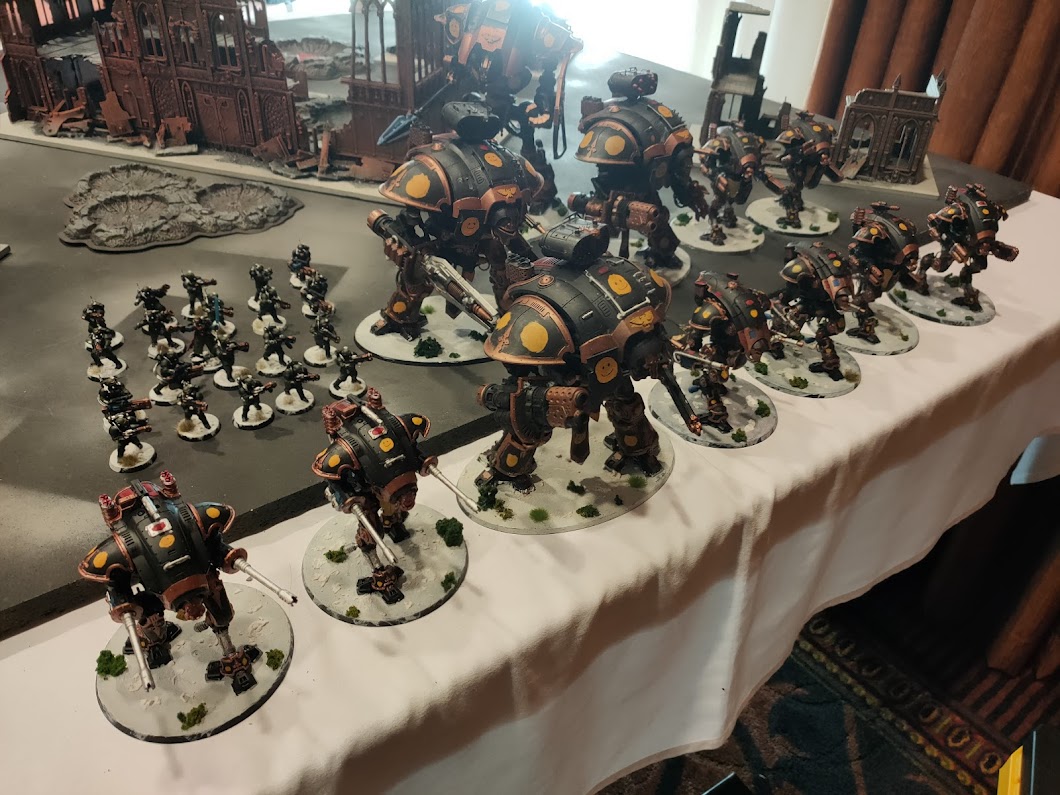
















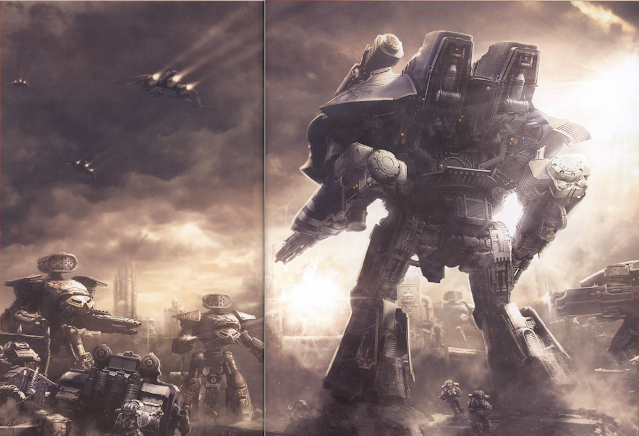





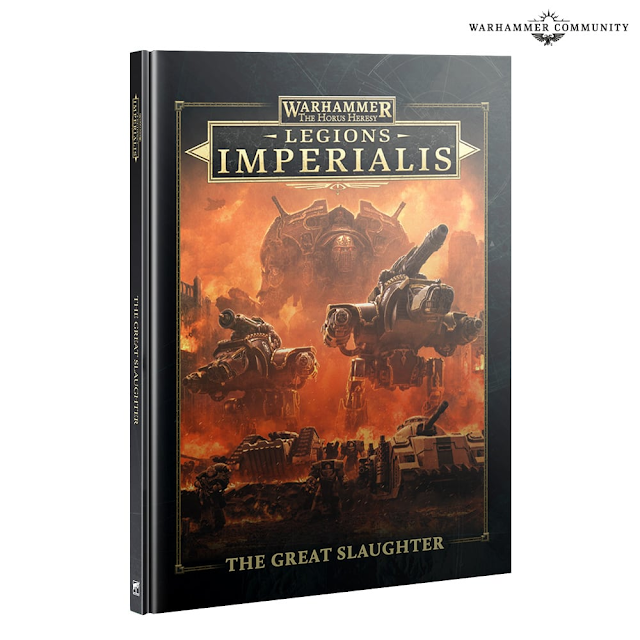



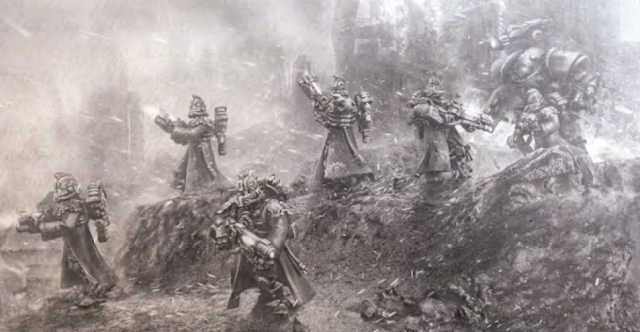
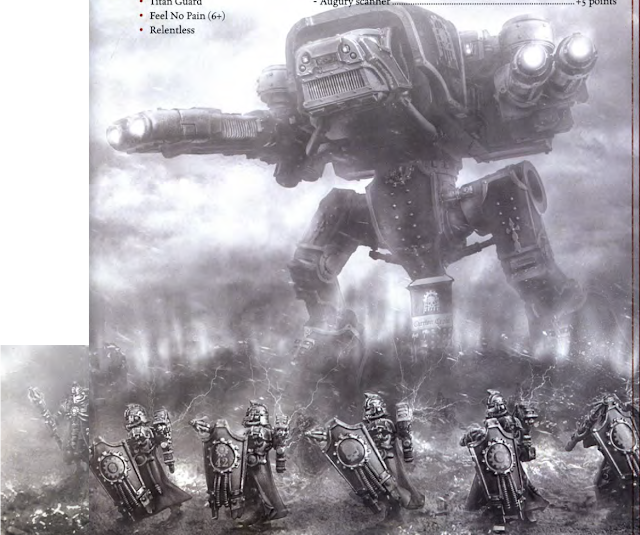

Great overview :)
ReplyDeleteThanks!
Delete